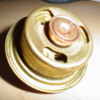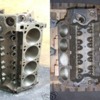The Cleveland's coolant system IS unique, that brass orifice beneath the T-stat regulates the amount of coolant that is recirculated through the engine during warm up, coolant flowing through that passage bypasses the radiator, it flows from the engine block outlet directly back into the water pump's suction. Removal of the thermostat allows coolant to recirc continuously through that orifice, even when the motor is warm, so a substantial amount of coolant bypasses the radiator and is not cooled. The cup shaped bottom of the Cleveland T-stat seats against the round orifice plate and plugs that passage, so the wrong T-stat, without that cup shaped bottom, also allows the same condition, the uncontrolled recirculation of coolant.
The design goal of the Cleveland engineers was quicker warm ups & lower emissions, so the Cleveland has the capacity to recirculate more coolant than a Windsor, this design required a method for shutting off the recirc passage after warm up. That is achieved with the special thermostat with the cup shaped bottom and copper button (which I think acts as a guide).
The "standard" looking T-stats that you refer to Michael are Windsor T-stats. This is a very common mistake, not just right coastal either, its a national epidemic. Parts guys have been handing out the wrong T-stat for Clevelands ever since 1970. If I had a dime for every wrong T-stat I've removed from a Cleveland motor, well, I would at least be able to fill my fuel tank once with premium. LOL

Normally the effect of a wrong T-stat isn't detected until the vehicle is taken for a long trip, has to climb a long steep grade, is operated in a very hot (desert) climate, is raced, operated in stop & go traffic, etc. The Cleveland will operate fine with the wrong T-stat on short trips.
You guys are probably thinking right now "this guy reads too many tech manuals!" LOL

Your sleepy friend on the PIBB, George




